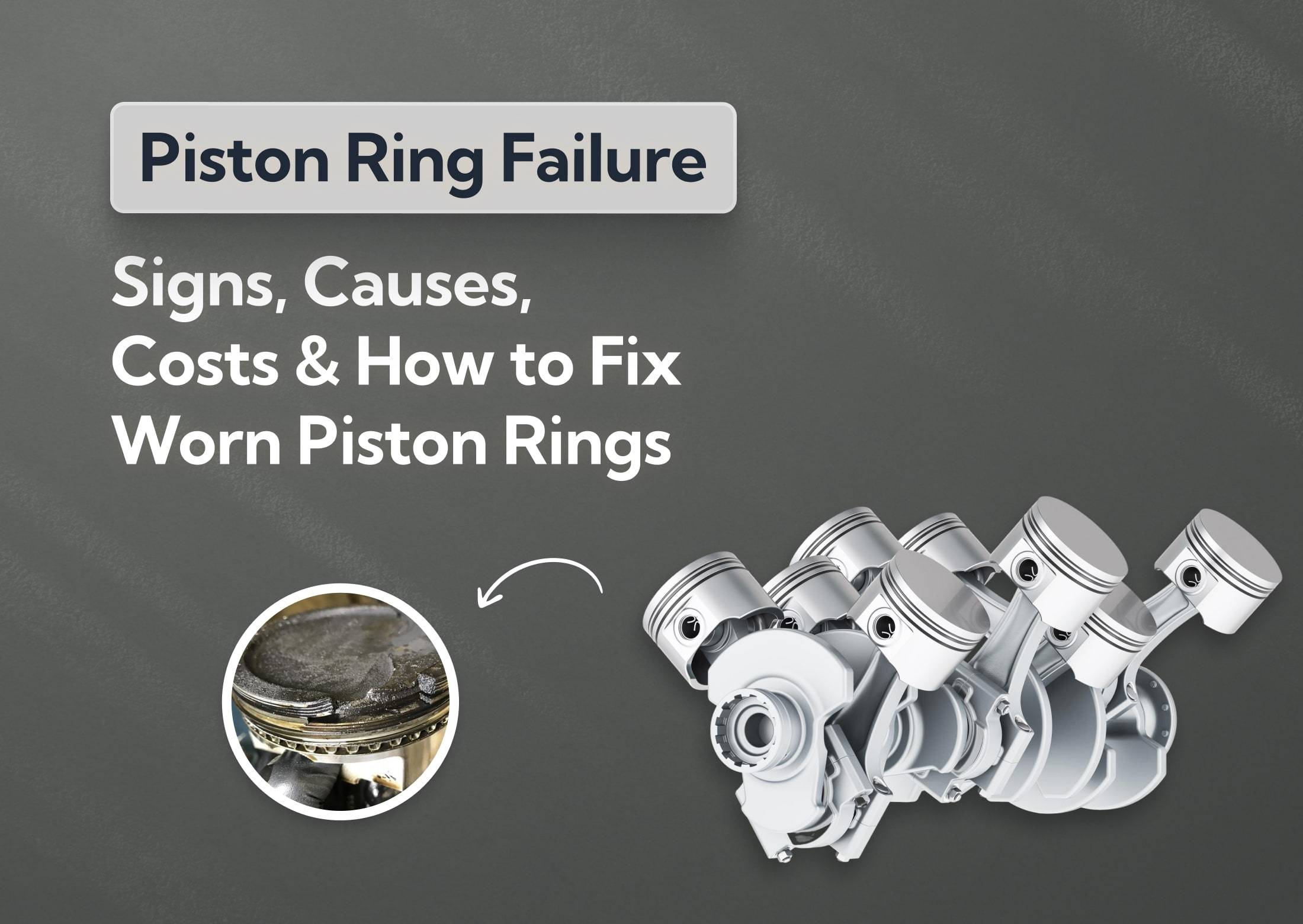Piston Ring Failure: Signs, Causes, Costs and How to Fix
Piston ring failure can rob your engine of power, burn through oil and lead to a costly repair. Here’s how to spot the signs early and keep the engine running strong.
Last updated: 25th November, 2025

Award-winning CEO driving growth and social impact across automotive, recycling, and technology-led enterprise platforms.

Listen to this story
Your engine's piston rings might be small, but when they fail it is anything but minor.
These thin metal bands seal the gap between each piston and cylinder wall. When they wear out, your engine loses compression, burns oil, and performance plummets.
Here's the problem: replacing worn piston rings requires a complete engine teardown. You're looking at labour costs in the thousands because a mechanic essentially has to rebuild your engine just to access them.
This is why maintaining your piston rings is critical. Prevention beats a repair bill that could total your car.
In today’s article, I’ll walk you through all that and more: signs of piston ring failure, what causes it, costs of fixing it and how to prevent it from happening in the first place.
What's in this article
- 1. What are piston rings and why do they matter?
- 2. Common signs of failing piston rings
- 3. What causes piston rings to fail?
What are piston rings and why do they matter?
Piston rings are thin, spring-loaded metal bands that fit into grooves around your engine's pistons. They create a sliding seal between the piston and the cylinder wall, two metal surfaces that are constantly moving against each other at high speeds.
They've got three critical jobs:
- Maintaining engine compression: Piston rings create a tight seal between the piston and the cylinder wall, which allows the engine to build stable compression. That pressure is what gives the engine its strength when you accelerate. Once the seal starts to weaken, the cylinders can’t hold pressure and the engine loses its punch. In serious cases, the drop in compression triggers rough running, hesitation and even misfires because the air-fuel mixture no longer ignites as it should.
- Preventing oil leakage and contamination: The rings also act as a barrier keeping engine oil out of the combustion chamber and vice-versa. When the rings wear down, oil slips past them and burns inside the cylinders. That leads to noticeable oil loss, smoky exhaust, and accelerated engine wear as contaminants circulate where they don’t belong.
- Enhancing fuel efficiency and emissions: Proper combustion depends on a clean, consistent seal and piston rings play a central role in achieving that. When they’re in good condition, the engine burns fuel more completely, which controls fuel consumption and emissions. Damaged rings disrupt that combustion process, forcing the engine to work harder and use more fuel.
Why should you care? Because when the piston rings stop working properly, all three functions collapse at once. Your engine loses power, guzzles oil, overheats and starts causing damage that spreads like a disease through other components.
Common signs of failing piston rings
When piston rings start wearing out, the engine usually gives you a few clear hints. Some are subtle at first, but they build into bigger problems if you ignore them.
Excessive oil consumption
Since their job is to keep oil out of the combustion chamber, piston rings let oil slip past the pistons and burn during each cycle when they’re worn. That’s why the dipstick drops faster than it should, especially once the engine warms up and the oil thins.
Long term, constant oil loss speeds up wear across the engine. The remaining oil breaks down quicker, heat builds up, and carbon deposits form inside the cylinders. If you leave it too long, the engine starts to run hotter, lose power and edge closer to needing major internal work.
Discolored smoke from the exhaust
You might also spot smoke drifting from the exhaust. That’s oil burning inside the combustion chamber, and it points straight back to worn rings letting oil slip past them. The smoke has a faint blue tint rather than the grey or white haze you’d see from condensation or a rich fuel mixture.
It’s most obvious:
- When you pull away from a stop and put the engine under load
- When you rev the engine while parked
- When the engine is warm and the oil is thinnest
Lack of engine power
One of the most noticeable changes is a drop in power. You press the accelerator and the car feels like it needs a moment to gather itself. That slack in response comes from weakened compression inside the cylinders.
It’ll be at its most pronounced when:
- Accelerating from low speeds
- Climbing a hill
- The car is fully loaded
- Merging onto a motorway
Rough idling or misfire
A rough idle happens when the piston rings fail because the cylinders can’t hold steady pressure, so the air-fuel mixture burns unevenly. You’ll feel a soft, rhythmic stumble that never really smooths out, even once the engine is warm.
If the loss of compression gets bad enough, that shaky idle can tip into an engine misfire as one cylinder simply can’t ignite the mixture properly. A misfire feels like a sharper version of rough idling.
The easiest way to tell if an engine misfire is from piston ring failure is to check for oil loss and blue smoke. If yes, you’ve most likely found the culprit.
Shuddering or stuttering
Since the cylinders can’t keep consistent pressure when piston rings wear out, each combustion cycle produces a slightly different amount of force. That inconsistency shows up as a stutter you can feel through the pedals or steering wheel.
To diagnose it, pay attention to when the shudder happens. If it’s most noticeable under load ( pulling away from a junction, climbing a hill or overtaking) that’s a strong hint the cylinders are struggling to build pressure.
Combine that behaviour with blue exhaust haze and oil loss and piston ring wear becomes a very likely culprit.
Engine knocking
Engine knocking is less common, but it sometimes shows up as a result of oil seeping through the worn piston rings. That oil burns and leaves carbon on the piston crown, valves and chamber walls.
As that oil burns, it leaves carbon deposits on the piston crown and inside the chamber. Carbon buildup creates hot spots. And hot spots cause pre-ignition or detonation, both of which can sound like knocking or pinging.
On top of that, the carbon buildup increases chamber temperatures and changes how the mixture burns, which triggers the knock.
What causes piston rings to fail?
There are five realistic failure paths: poor maintenance, overheating, excessive engine wear, poor-quality or contaminated fuel and improperly installed or defective rings.
Poor maintenance and lack of oil changes
Old, dirty oil loses its ability to lubricate and cool the cylinders. That speeds up wear on both the rings and the cylinder walls. Once the film breaks down, friction skyrockets and the rings start scraping themselves to death. So if you don’t get clean, fresh oil every 5,000 to 7,500 miles (e.g., because you neglected routine maintenance), you might cause yourself piston ring failure.
Engine overheating
Engine overheating makes the rings and pistons expand too much, softens the metal, and reduces the rings’ spring tension. That lets them lose their seal and wear quickly. A weak cooling system or aggressive driving pushes temps even higher, creating a cycle where heat, friction and carbon buildup destroy the rings fast.
Excessive engine wear
Older engines with high miles have thousands of hours of heat cycles, friction and combustion pressure behind them. Over time, the ring faces wear down, the cylinder walls lose their crosshatch and blow-by increases. If you skipped a few oil changes along the way, that wear happens even faster because dirty oil can’t protect the metal.
Poor-quality or contaminated fuel
Low-quality or contaminated fuel won’t grind down the rings directly, but it’ll mess with combustion. Additives, dirt and water in the fuel cause detonation and carbon buildup. Detonation hammers the rings and piston lands. Carbon traps heat and scratches the cylinder wall. Over time, that abuse wears your rings faster and makes the engine run less efficient.
Improper installation or manufacturing defects
If the rings aren’t sized, gapped or oriented correctly, they’ll never seat right and will wear out fast because of that. Cheap or defective rings also lose tension early, or they’ll crack under stress. This is why I always recommend going with OEM parts and having a mechanic handle this job; these aren’t things the average untrained driver will know.
What the experts say

Steven Jackson OBE
How much does it cost to fix worn piston rings?
It’s expensive. For a typical mid-sized car you might expect something in the £800 to £1,500 range if all else is fine. But if there’s wear or destruction beyond just the rings, expect £2,000 to £3,000 or more.
Piston ring repair cost
There’s no real “piston ring repair”. Once they lose tension and stop sealing for any reason, they’re done.
What actually happens is piston ring replacement, but that job is huge because the engine has to be torn down enough to remove the pistons. Shops often call it a “repair” because you’re repairing the vehicle itself, but the rings themselves are always replaced.
Piston ring replacement cost
If you're replacing worn piston rings in the UK, expect to pay mainly for labour (often 10 to 20+ hours at around £60 to £1200 per hour), plus the ring kit, gaskets, head bolts, fluids and possibly machine-work if the cylinder walls need re-honing.
Here’s a look at what typical ranges look like based on the going labour and parts rates right now:
| Vehicle type | Typical engine / situation | Average cost estimate | Notes |
|---|---|---|---|
| Economy hatch (4-cyl) | Simple petrol 1.0-1.6L | £700 to £1,200 | Easy access, fewer parts |
| Mid-size family car (4-6-cyl) | Common saloon or estate | £900 to £1,800 | More labour, more ancillaries |
| Luxury / performance (premium brand) | V6/V8, turbo, complex plumbing | £1,500 to £2,500+ | Higher labour, more risk |
| Location adjustment – North UK | Lower labour region | ~10-30% less than London | Independents, lower rates |
| Location adjustment – London / SE UK | High labour cost area | ~10-30% more than average | Premium garage rates |
Factors that affect piston ring fixing costs
The rings themselves are cheap. The labour and ‘while you’re in there’ work is what hurts. Here’s what goes into the final cost you’re paying:
- Labour time and complexity: Like I said earlier, it’s a full engine or major disassembly job (head removal, pistons out, re-installation). A piston ring job is 8 to 15+ hours, which is already £800 to £1,500+.
- Engine size and layout: Smaller 4-cylinder engines are cheaper to work on than V6, V8, turbocharged and exotic layouts because they’re easier and require less (if any) specialised expertise.
- Parts quality and extras needed: While ring kits themselves are relatively inexpensive, you’ll also need gaskets, seals, possibly new head bolts, fluids and if the cylinder walls are worn you might need machining. If you go with OEM parts (which you should), they’ll cost more.
- Extent of additional damage: If the cylinder bores are scored or the pistons are damaged, the job gets more expensive because there’s machine work and extra parts involved.
- Diagnostics and teardown overhead: The teardown and reassembly work adds fixed overhead (engine mounts, ancillaries, coolant/oil system work) which means even a “simple” ring job has a high baseline.
High-mileage and older engines naturally have more wear, so expect the mechanic to tell you other things need to be repaired if your car’s more than 10 years old or has 100,000+ miles on it.
And of course, workshop labour rates vary a lot by region. For instance, in SW London, the average garage charges £141 per hour. Compare that to the national average of £76 or the cheapest area (Huddersfield) at £47.
If you want to be on the cheaper end wherever you’re located, independent garages almost always charge significantly less per hour than brand and dealer garages.
Additional costs to consider in piston ring repairs
There are also quite a few things people don’t think about until the engine’s already open. Additional costs include:
- Gasket and seal kits: Technically you only have to replace the head gasket, but in practice you buy a top-end gasket kit because it prevents repeat labor and avoids annoying leaks later.
- Head bolts: Most modern engines use stretch bolts that can’t be reused. A fresh set is standard practice.
- Fluids, filters and consumables: Fresh oil, coolant, filters, sealants and shop supplies are guaranteed line items.
- Engine cleaning: Hot-tank cleaning, ultrasonic cleaning or media blasting of the head and pistons isn’t always mandatory, but if there’s a lot of carbon buildup, your mechanic will recommend it.
Then you have to remember piston ring failure affects how the rest of your engine performs. If you’re in the shop because of something serious like a misfire, 9 times out of 10 there’ll be hidden damage and repairs as well.
The issues I see most often are:
- Scored or oval cylinder walls
- Damaged grooves where the rings sit
- Worn bearings from diluted oil
- Valve issues
- Clogged or damaged PCV system
- Timing components (as preventative work)
DIY vs professional piston ring repair costs
A DIY piston ring job is technically cheap on paper, but extremely expensive in time, tools, and risk. The rings themselves might cost £10 to £30. Add £150 to £300 for gasket sets, bolts, fluids and basic machine work.
If you already own an engine stand, torque wrenches, micrometers, ring compressors and lifting gear, you might finish the job for £300 total. But if you don’t have those specialty tools already, the ROI is practically nonexistent.
And even then, we’re not considering the fact a piston ring job requires advanced mechanical knowledge and mistakes destroy engines. If you do that, it’ll become far more expensive than paying a shop.
How to fix worn piston rings
Now, let’s go through the process of actually fixing your failed piston rings.
1. Inspect the engine for damage.
The first thing the mechanic will do is check each cylinder’s ability to hold pressure. Low or uneven compression is what they’re looking for. They start with compression and leak-down tests to pinpoint where pressure is escaping. Then, a borescope lets them check for carbon buildup, scoring and oil in the chamber.
Once the head and pistons come out, they measure the cylinder walls for wear. They’ll also inspect the ring lands for cracks and check bearings and oil for signs of deeper damage.
If everything is within spec, new rings are enough. If the bores, pistons and/or bearings are worn, the job becomes a full rebuild instead of a simple ring replacement.
2. Remove the old piston rings.
After the preliminary repair checks are finished, the mechanic will get right down to business. They’ll…
- Remove the piston from the connecting rod.
- Clean off carbon so the rings aren’t stuck.
- Use a ring expander tool to spread each ring gently.
- Lift the top ring off first, then the second, then the oil control rings.
- Inspect the ring grooves for damage or heavy carbon.
- Clean the grooves with a ring-groove cleaner before fitting new rings.
3. Install new piston rings.
Before the rings go on, the mechanic coats the piston and grooves with clean engine oil so the rings slide in smoothly and don’t grab on first startup. They’ll also oil the rings themselves after installation so everything beds in gently when the engine fires for the first time.
Then they’ll use a ring expander to fit each new ring onto the piston without forcing it, then make sure every ring sits flat in its groove. After that, they rotate the ring gaps so they’re spaced apart, which helps the engine seal properly once it runs.
4. Reassemble the engine and test.
Once the new rings are on, they reinstall the pistons with a ring compressor, refit the head with a fresh gasket, torque all bolts to spec and reconnect the timing and ancillaries. After reassembly, they refill the fluids, start the engine, check for leaks, verify compression and let it warm up to confirm everything is sealing and running smoothly.
They’ll prime the oil system before the first start so the new rings and bearings aren’t running dry. After it fires, they monitor temps, oil pressure and idle quality, then do a short road test to make certain the rings are bedded in properly and there are no leaks or noises.
5. Seek professional help.
Piston ring jobs are always a job for a skilled mechanic because replacing piston rings isn’t simple component swapping. You’re tearing deep into the engine, measuring bores to tight tolerances, handling precision parts and reassembling everything so it seals, times and lubricates correctly.
Anyone reading about worn rings is almost never in a position to do this themselves, and trying usually leads to bigger failures and a full rebuild instead of a straightforward repair.
The unfortunate reality is that it’s an expensive but necessary repair, which brings us to our next question.
Is it worth fixing worn piston rings or should you scrap the car?
It depends on the car’s value, the overall condition of the engine, and how much collateral damage the worn rings have already caused. Ring jobs are labour-heavy, so the economics matter more than the parts.
When is fixing worn piston rings worth it?
Fixing worn piston rings is only worth it when the value of the car, or the life you can get out of it afterward, justifies the cost of the repair.
Here’s when that is worth doing:
- Engine damage is limited.
- The condition is otherwise solid.
- The car holds strong market value.
- It’s harder to replace than to fix.
- Mileage is relatively low (< 100,000 miles).
- The car is less than 10 years old.
When scrapping the car is a better option
Since it’s a costly job, it makes more sense to scrap your car in a lot of instances; primarily when the repair cost is higher than the car’s actual value or when the engine damage is only one problem in a long list.
Here’s when scrapping becomes the smarter move:
- The car has multiple other issues.
- Repair costs are > 50% of its market value.
- The engine needs a full rebuild or replacement.
- There are other maintenance issues just over the horizon.
- Mileage is over 100,000 and/or the car is older than 10 years.
It makes more sense when the repair cost is higher than the car’s actual value or when the engine damage is only one problem in a long list.
Preventive tips for maximizing piston ring life
Piston rings last a long time when the engine runs cleanly and stays well lubricated. You don’t need to baby the car, but a few habits go a long way toward keeping the cylinders healthy and avoiding the kind of wear that leads to expensive repairs.
Regular oil changes
Changing your engine oil on time is one of the simplest ways to protect the piston rings. Fresh oil keeps the rings coated, reduces friction, and stops debris from scratching the cylinder walls. Once the oil gets old and dirty, it loses that protective layer and turns into an abrasive mix that speeds up ring wear.
Most petrol cars in the UK are happiest with a fully synthetic oil and a service interval somewhere between 5,000 and 7,500 miles, though high performance engines or diesels generally need shorter gaps. That said, when it comes to the exact oil type and frequency, follow the manufacturer’s recommendation.
Use high-quality fuel
Running clean, high quality fuel helps the engine burn it evenly and prevents carbon from building up around the piston rings. When the fuel combusts the way it’s supposed to, it leaves far fewer deposits behind, which means the rings can move freely and maintain a tight seal.
Low-octane fuel is the real risk here. It can ignite earlier than intended, which causes knocking, rough running, and that sluggish feeling when you accelerate. All of that extra stress heats the cylinders and speeds up wear on your piston rings.
Avoid short trips and aggressive driving
Frequent short trips never give the engine enough time to warm up properly, so moisture and unburnt fuel stay mixed in with the oil. That diluted oil can’t protect the piston rings and the added friction slowly wears them down.
On the other end of the spectrum, aggressive driving piles heat and pressure onto the rings. That tires out your engine and breaks downt the cylinder walls faster. Make an effort to always drive smoothly and steadily to keep temperatures stable.
Engine tuning and regular diagnostics
Keeping the engine properly tuned removes a lot of the strain that would otherwise land on the piston rings. When the mixture and timing are set correctly, the cylinders don’t run hotter than they’re supposed to. That means the rings aren’t constantly fighting unstable combustion.
As for spotting early clues that something isn’t sealing as it should, that’s where routine diagnostics come in. Have a technician look at your engine when you take it in for servicing because they’ll be able to pick up on wear patterns and small issues you’d probably never notice until the engine starts acting up.
Frequently asked questions
If the damage isn’t serious, it’s usually possible to keep the car moving. But even then, it’s not a good idea for long. Worn rings let oil burn and raise engine temperatures. The more you drive, the more damage builds up, and your engine could potentially seize.
Yes. Once the rings stop sealing properly, the engine wastes fuel because it has a harder time controlling combustion. You’ll notice the car feels weaker while using more fuel to do the same work.
Stay on top of oil changes, use the right fuel and avoid habits that push the engine into harsh temperature swings. A few routine diagnostic checks throughout the year also help you catch early issues before they turn into more expensive ones.
It depends on how severe the wear is but most engines decline quickly once the rings start failing. Some drivers can limp along for as much as 5,000 miles, others only a few weeks. The moment you see signs like smoke, rising oil use or low compression, plan for repairs ASAP.
About Car.co.uk

Share on
Latest news & blogs










